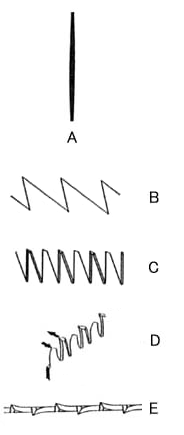| A saw. Saws are the most used tool in Japanese carpentry.
They divided into two broad groups: the ripsaw, which cuts along the wood grain
and is known as *tatebikinoko
縦挽鋸 and the crosscut saw, which cuts across the wood grain, and is known as
*yokobikinoko 横挽鋸. The two saws do not differ much: they both have a blade, nokomi 鋸身,
and a wooden handle, e 柄. The blade is made from a thin steel plate with
teeth, nokoba 鋸歯, on one or both sides, which have been tempered by heating.
When the blade is viewed in cross-section, it expands slightly in the center.
The middle of the blade is usually made a little thicker than the teeth and the
back, in order to achieve greater strength. The handle is made from a light wood
such as paulownia kiri 桐, or cypress hinoki 桧. The difference
between the ripsaw and the crosscut saw is in the shape of the cutting teeth.
The ripsaw has wedge-shaped teeth with sharply pointed tips, whereas the teeth
in the crosscut saw are not pointed, but finish in a blade edge. This not only
helps the cutting action across the wood grain but also gives a good finish on
the cutting surface. The cutting teeth of the saw are set alternately facing the
right and left sides, a feature known in Japanese as asari 歯振. This helps
to reduce friction between the blade and the groove when sawing, and smooths the
action of drawing the blade back and forth. Incidentally, most Japanese saws cut
during the pull stroke, not the push stroke. |

